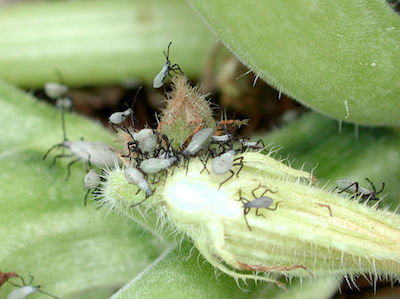by Marisa Thompson, with guest contributor, Dr. Amanda Skidmore, NMSU Extension Integrated Pest Management Specialist for Urban and Small Farms
Question: I've always been told that squash bugs shouldn't be squashed, but should be placed in a covered jar or container because, when squashed, they emit a pheromone-binding protein that the other squash bugs can sense from distances and will be attracted to their brothers in my yard. Is this fact or fiction?
-Carol B., Los Lunas
 Squash bug nymphs on a squash blossom (photo by Pollinator, Wikimedia Commons)Answer: I hadn’t heard this scary detail, so I reached out to Dr. Amanda Skidmore, NMSU Extension Integrated Pest Management (IPM) Specialist for Urban and Small Farms, for input: “Insects have many different forms of communication, and pheromones are one of the main ways they pass messages to one another. True bugs (including squash bugs) are known to have both "aggregation" and "alarm" pheromones. An aggregation pheromone basically says, "I found a great resource, come join me," while an alarm pheromone says, "Danger, avoid!" From researching your question, I haven't come across anything saying that crushing squash bugs would attract more to your plants. Crushing a squash bug would release an alarm pheromone, which would then send a signal to other bugs to avoid that area. These pheromones won’t last long in the environment (especially if the insect is dead and not actively releasing it), so I would say remove them by hand if you have a small number of plants. You can try swiping them into a bucket of soapy water or corral them under cardboard, as discussed in last week’s column. One reason you might see an increase in the number of squash bugs on a plant is that the plant may also be sending a chemical signal into the environment telling the insects that it is in distress and attracting more pests to it.”
Squash bug nymphs on a squash blossom (photo by Pollinator, Wikimedia Commons)Answer: I hadn’t heard this scary detail, so I reached out to Dr. Amanda Skidmore, NMSU Extension Integrated Pest Management (IPM) Specialist for Urban and Small Farms, for input: “Insects have many different forms of communication, and pheromones are one of the main ways they pass messages to one another. True bugs (including squash bugs) are known to have both "aggregation" and "alarm" pheromones. An aggregation pheromone basically says, "I found a great resource, come join me," while an alarm pheromone says, "Danger, avoid!" From researching your question, I haven't come across anything saying that crushing squash bugs would attract more to your plants. Crushing a squash bug would release an alarm pheromone, which would then send a signal to other bugs to avoid that area. These pheromones won’t last long in the environment (especially if the insect is dead and not actively releasing it), so I would say remove them by hand if you have a small number of plants. You can try swiping them into a bucket of soapy water or corral them under cardboard, as discussed in last week’s column. One reason you might see an increase in the number of squash bugs on a plant is that the plant may also be sending a chemical signal into the environment telling the insects that it is in distress and attracting more pests to it.”
 Magnified view of diatomaceous earth (photo by Zephyris, Wikimedia Commons)Question: Are diatomaceous earth and kaolin clay the same product? Since I already have diatomaceous earth, will it do the same thing or as good a job as kaolin clay?
Magnified view of diatomaceous earth (photo by Zephyris, Wikimedia Commons)Question: Are diatomaceous earth and kaolin clay the same product? Since I already have diatomaceous earth, will it do the same thing or as good a job as kaolin clay?
-Carol B., Los Lunas
Answer: Great question! Research I’ve done as a graduate student with kaolin clay involved mixing the fine clay dust with water and coating the plants to see if the chalky white surface reduces sun stress on young pecan trees or if it affects the photosynthetic rates on pecan leaves. (Please note, while kaolin clay is labeled for use as a pesticide in pecan production, it is not labeled for this sun stress-related use.) Kaolin clay is labeled for a number of other applications. For example, it is sometimes used in organic apple production to help prevent damage from coddling moths. The white clay film is just rinsed off of mature fruit when they’re harvested. Kaolin clay can also be used as a white-wash instead of a white latex paint solution applied to young tree trunks in winter to prevent southwest injury, aka winter sunscald. (For more on that, visit the blog version of this column at https://nmsudesertblooms.blogspot.com and search “injury.”)
I’ve been wanting to learn more about diatomaceous earth (DE) and how it works to control insect pests for some time. As Dr. Skidmore explained, “Diatomaceous earth and kaolin clay are very similar products and can work in the same way, depending on how they’re used. You can mix diatomaceous earth in water and spray it onto a plant to help it bind to plant surfaces. Neither of these products actively kill insects, but they do make it uncomfortable to be on the plant, so they’re good deterrents to help reduce the overall number of pests. Kaolin clay can be found under the product name ‘Surround WP,’ but generic brands also exist. As always, read and follow all product labels carefully.”
For more gardening information, including decades of archived Southwest Yard & Garden columns, visit the NMSU Extension Horticulture page (http://desertblooms.nmsu.edu/), follow us on social media (@NMDesertBlooms), or contact your County Extension office (https://aces.nmsu.edu/county).
Both Dr. Marisa Thompson and Dr. Amanda Skidmore are Extension Specialists for New Mexico State University and are based at the Agricultural Science Center at Los Lunas.


